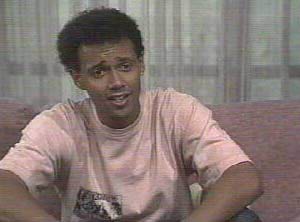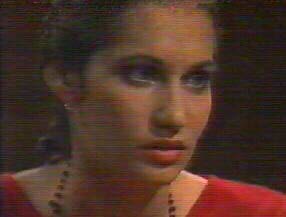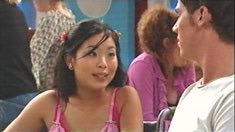|
.
Comment
> Racism
in Ramsay Street? by
Steve
Neighbours
doesn’t exactly have a history of ethnic diversity. With very
few exceptions, the show tends to rely on stereotypes or it
just blatantly ignores the fact that people who aren’t whiter
than white (in more sense than one) exist. But how intentional
is this? In short; is Neighbours racist?
Erinsborough
is a fictional suburb of one of Australia’s most cosmopolitan
cities. Melbourne has the largest Greek population outside
Greece itself, with other large communities ranging from Italian,
Turkish and Spanish to Chinese and Maltese. Of course, nobody
is expecting such diversity out in the suburbs, but it would
be realistic to reflect a small part of this.
 |
From
the beginning, it was obvious that while strippers were (hesitantly)
welcomed in Ramsay Street, anyone without white skin wouldn’t
even make it into the district. The first appearance of a
black character came in 1986 when various residents befriended
aspiring swimmer Pete Baxter. While his race never became
an issue and was infact never even mentioned, he didn’t exactly
set the world alight in terms of storylines or screen presence.
A similar set-up occurred a few years later when Madge and
Harold returned from England with one big souvenir; Eddie
Buckingham. Sadly, he brought little to the show but a Dick
Van Dyke-style cockney accent and was soon packed off back
to England. Neighbours’ early attempts at presenting a wide
intersection of society amounted to very little indeed. In
1990, the Alessi twins arrived. While still white, they at
least acknowledged the fact that there is a huge Italian population
living in Australia. As time went on, the family became like
any other Neighbours clan, with family members turning up
from nowhere and taking the place of departing Alessis. Indeed,
many of the critics seemed to conveniently forget that Neighbours
had featured this family; relatively free of stereotypes,
unless you count Cathy Alessi and her obsession with spaghetti
sauce.
 |
The
arrival of Sally Pritchard, played by Aboriginal actress Brenda
Webb was another step forward for the show. In her extended
guest role as a teacher of Japanese who had a fling with student
Rick Alessi, her Aboriginal heritage was never once mentioned.
This meant that Neighbours seemed to have finally caught on
to the fact that people who weren’t white didn’t necessarily
have to become the subject of a hard-hitting socially-relevant
storyline. Then, in the mid-90s, the show suddenly found itself
being accused of racism and so, to prove otherwise, they decided
to tackle the issue in a way that only Neighbours could. The
Lim family, five of the worst actors the show has ever seen
(and that’s saying something) moved into number 22 on a temporary
basis. It seemed that from the outset they were there with
a message; racism is wrong and foolish and all racists are
basically just misguided individuals with too much time on
their hands. In an attempt to almost poke fun at its accusers,
the Lims became involved in a farcical plot whereby neighbour
Julie Martin accused them of eating the family dog, Holly.
The
third incarnation of Lucy Robinson once had a conversation
with a man at an interview for the surgery receptionist’s
job. He told her that he was an immigrant and that he was
finding it virtually impossible to get any kind of work in
Australia. A small commentary from Neighbours on an all too
familiar subject. It probably went unnoticed by most people
and was a good example of how the show can sometimes underplay
the issues in a way other soap operas fail to do. A similar
issue was explored in 2002, following the news stories about
the ‘boat people’ and Christmas Island. Leo Hancock and Michelle
Scully found a refugee hiding in Lou’s empty house and he
explained about the persecution he had experienced in his
home country. While not as subtle as Lucy’s chance meeting,
it offered a chance to show the different perspectives of
the residents on the issue, with Michelle, Joe and Harold
all having different ideas on how the illegal immigrant should
be dealt with.
When
Hindu character Vikram Chatterji started working for Philip
at the newsagency, it seemed that Neighbours had managed to
create a character whose race and religion had nothing to
do with who he was. However, as time went on, Vikram had very
little impact on the show and his sister Lata arrived. She
was only a teenager and had a fling with Brett Stark, much
to the horror of her brother. This storyline seemed to be
highlighting the strictness of a Hindu upbringing, with Lata
seeming very relaxed about her schooling and religion, while
Vikram made it clear that she had no room for boys in her
life and sent her away to live with an aunt. It seemed to
base many of its ideas on stereotypes, which was a shame as
Vikram had been reasonably free of them up until that point.
 |
The
arrival of a brand new family, the Scullys, with no connections
to any existing characters, in 1999, begged the question -
why did they have to be a white, Anglo family? The newcomers
could easily have been Greek, Italian, Vietnamese... Nobody
can deny that the Scullys were completely different from anything
we’d seen before on Ramsay Street, but there are still other
places they could take it. In 2002, New Zealander, of Malaysian
descent, Michelle Ang joined the cast with little fanfare
but playing a great character. As
time went on, the character of Lori Lee seemed to be given
all the best storylines - a cheating boyfriend, paralysis
and an unwanted baby, all in the space of six, short months.
It simply showed that Neighbours has always been capable of
expanding its casting horizons. Apparently, the show is now
working on redressing the balance, with news that we will
have a new Eastern European character, Liljana Bishop, in
the cast by the end of the year. Hopefully, Neighbours has
learnt its lesson from the past, and the newcomer will be
more Lori Lee than Eddie Buckingham. Time will tell.
Back
|

